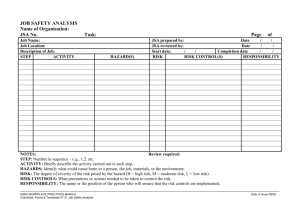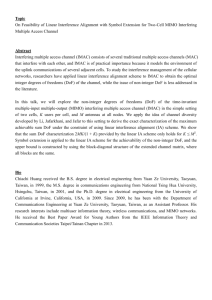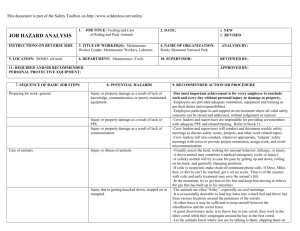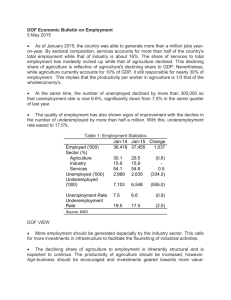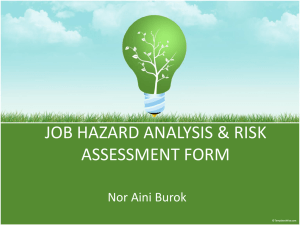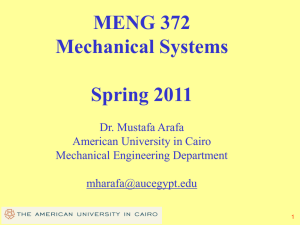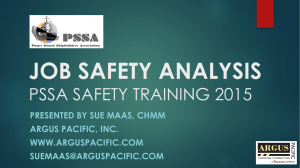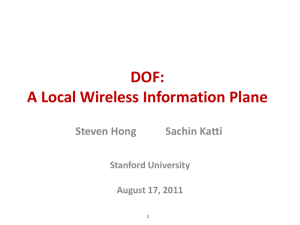Safety: Last Minute Risk Assessment & STOP WORK Authority
advertisement
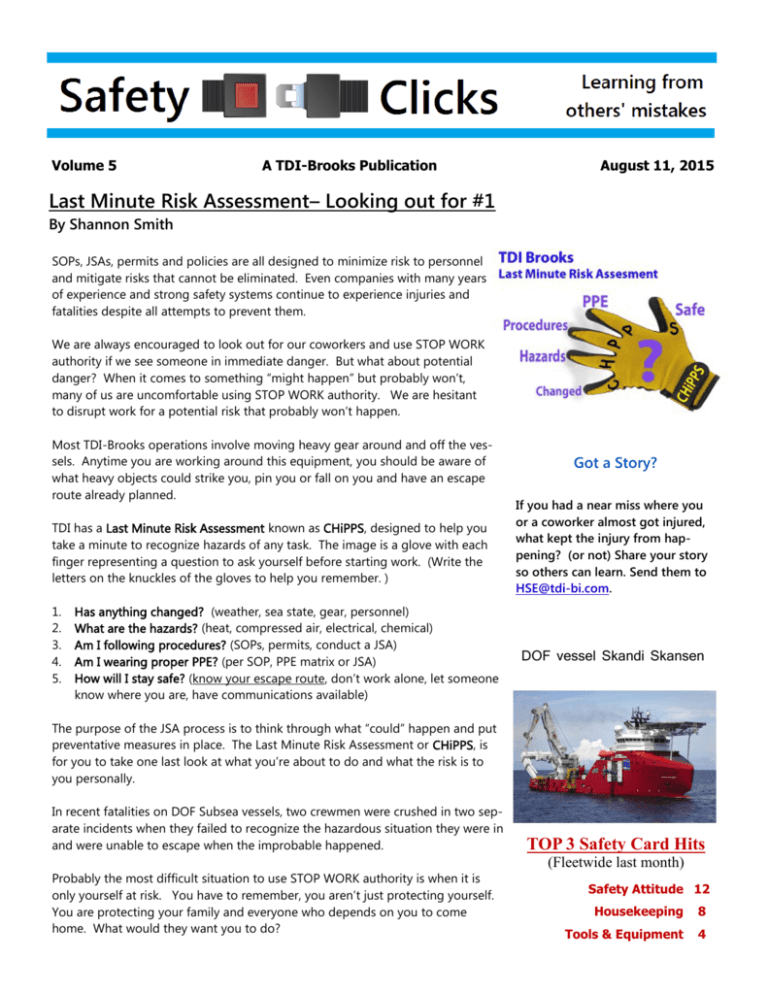
Volume 5 A TDI-Brooks Publication August 11, 2015 Last Minute Risk Assessment– Looking out for #1 By Shannon Smith SOPs, JSAs, permits and policies are all designed to minimize risk to personnel and mitigate risks that cannot be eliminated. Even companies with many years of experience and strong safety systems continue to experience injuries and fatalities despite all attempts to prevent them. We are always encouraged to look out for our coworkers and use STOP WORK authority if we see someone in immediate danger. But what about potential danger? When it comes to something “might happen” but probably won’t, many of us are uncomfortable using STOP WORK authority. We are hesitant to disrupt work for a potential risk that probably won’t happen. Most TDI-Brooks operations involve moving heavy gear around and off the vessels. Anytime you are working around this equipment, you should be aware of what heavy objects could strike you, pin you or fall on you and have an escape route already planned. TDI has a Last Minute Risk Assessment known as CHiPPS, designed to help you take a minute to recognize hazards of any task. The image is a glove with each finger representing a question to ask yourself before starting work. (Write the letters on the knuckles of the gloves to help you remember. ) 1. 2. 3. 4. 5. Has anything changed? (weather, sea state, gear, personnel) What are the hazards? (heat, compressed air, electrical, chemical) Am I following procedures? (SOPs, permits, conduct a JSA) Am I wearing proper PPE? (per SOP, PPE matrix or JSA) How will I stay safe? (know your escape route, don’t work alone, let someone know where you are, have communications available) Got a Story? If you had a near miss where you or a coworker almost got injured, what kept the injury from happening? (or not) Share your story so others can learn. Send them to HSE@tdi-bi.com. DOF vessel Skandi Skansen The purpose of the JSA process is to think through what “could” happen and put preventative measures in place. The Last Minute Risk Assessment or CHiPPS, is for you to take one last look at what you’re about to do and what the risk is to you personally. In recent fatalities on DOF Subsea vessels, two crewmen were crushed in two separate incidents when they failed to recognize the hazardous situation they were in and were unable to escape when the improbable happened. Probably the most difficult situation to use STOP WORK authority is when it is only yourself at risk. You have to remember, you aren’t just protecting yourself. You are protecting your family and everyone who depends on you to come home. What would they want you to do? TOP 3 Safety Card Hits (Fleetwide last month) Safety Attitude 12 Housekeeping 8 Tools & Equipment 4 Vol 5 August 11, 2015 Page 2 of 2 Failure to Assess Risk Results in 2 DOF Fatalities DOF Subsea is a leading offshore company with operations in the North Atlantic, Gulf of Mexico, Brazil, Asia and West Africa. It employs over 1,858 subsea and marine crew and has well established safety and training processes. Yet despite all policies, procedures and precautions, they have had two employee fatalities in a 6 month time span. The first occurred when the Skandi Skansen was at the dock during a change out of a cabelar – a large, heavy piece of equipment resembling a 4.5 foot tall, roughly 2 ft wide metal wheel. This is a common operation on many DOF vessels. A permit to work had been completed and a toolbox talk was held before work began. However, a risk assessment or JSA was not conducted. When the cabelar was lowered, it was not placed in the center of the chain locker lid as intended, but near a railing system of narrow, parallel deep channels on the deck. The crew did not check the landing position. As soon as the wheel was disconnected, they began manually rolling it into position. The rim of the wheel rolled into the gap in the railing system, causing the wheel to fall against the bulkhead, pinning two crewmen. One escaped with only first aid injuries. The other was fatally crushed. The investigation revealed that the cabelar was not handled by the intended vessel design method, the lifting and handling appliances to properly handle the cabelar were not available and there was inadequate design review by the company for this operation. In addition, the crew failed to comply with safe working practices and did not identify hazards and risks of the task. The company issued a STOP WORK to the fleet stating that NO cabelars shall be free rolled. The corrective action plan included an evaluation and development of a safe method of installing cabelars throughout the fleet. The second fatality occurred July 14, 2015 aboard the Skandi Pacific during severe weather. A crewman was attempting to secure cargo when a wave came over the back deck of the vessel. The wave shifted the cargo and the crewman was crushed between a moving mini-container and a cargo skip. This accident is still under investigation. Safety Tips– Word Find See how many you can find. ASSESSMENT CHiPPS JSA PPE STOP WORK AWARENESS ESCAPE ROUTE PROCEDURES SAFE WEATHER CHANGED HAZARDS PERMIT SEA STATE [Words can go up, down, backwards or diagonally]
